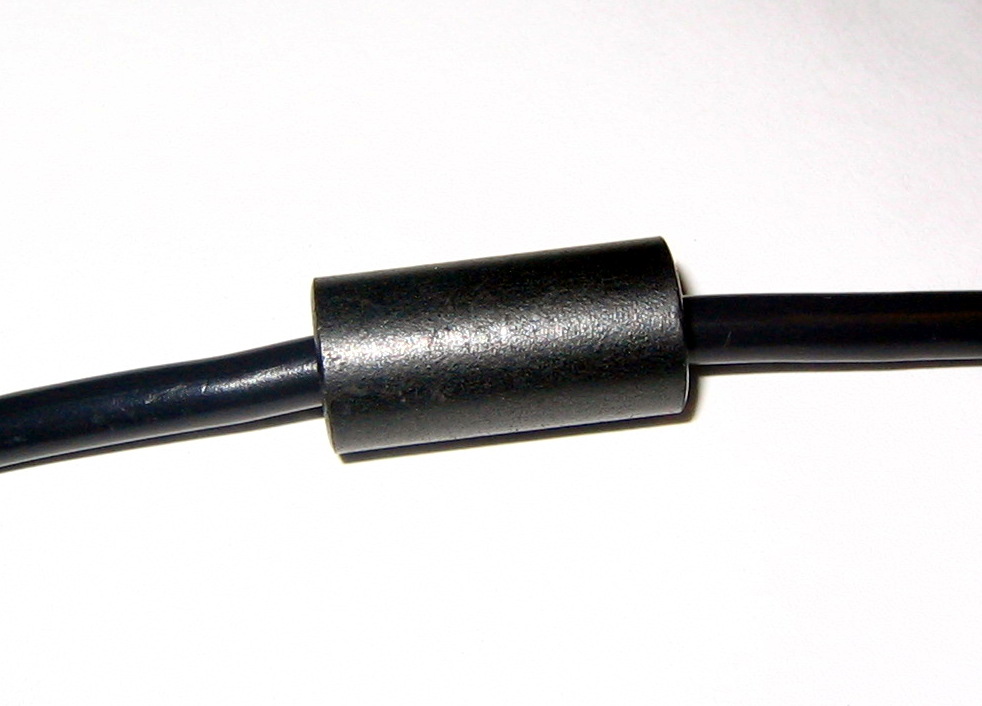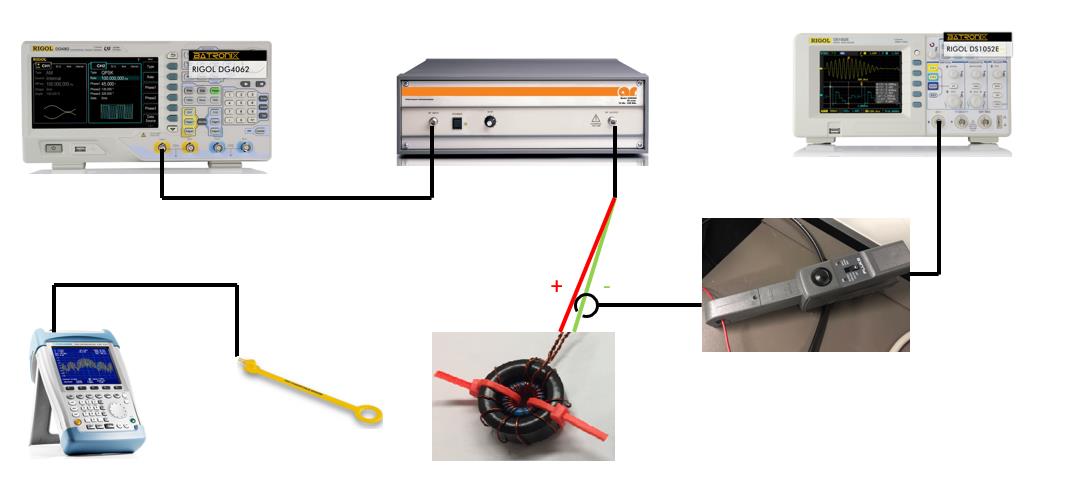Choke (electronics) on:
[Wikipedia]
[Google]
[Amazon]
 In
In

 Chokes are divided into two broad classes:
* Audio frequency chokes (AFC) – designed to block
Chokes are divided into two broad classes:
* Audio frequency chokes (AFC) – designed to block
 The common-mode (CM) choke, where two coils are wound on a single core, is useful for suppression of electromagnetic interference (EMI) and
radio frequency interference (RFI) from
The common-mode (CM) choke, where two coils are wound on a single core, is useful for suppression of electromagnetic interference (EMI) and
radio frequency interference (RFI) from  The difference between the balanced twisted windings CM choke and conventional balanced two winding CM choke is that the windings interact in the center of the core open window. When it is conducting CM current, the balanced twisted winding CM inductor can provide identical CM inductance as the conventional CM inductor. When it is conducting DM current, the equivalent current loops will generate inversed direction magnetic fields in space so that they tend to cancel each other.
A current is passed through inductor, and a probe measures the near field emission. A signal generator, serving as a voltage source, is connected to an amplifier. The output of the amplifier is then connected to the inductor under measurement. To monitor and control the current flowing through the inductor, a current clamp is clamped around the conducting wire. An oscilloscope connected to the current clamp to measures the current waveform. A probe measures the flux in the air. A spectrum analyzer connected to the probe collects data.
The difference between the balanced twisted windings CM choke and conventional balanced two winding CM choke is that the windings interact in the center of the core open window. When it is conducting CM current, the balanced twisted winding CM inductor can provide identical CM inductance as the conventional CM inductor. When it is conducting DM current, the equivalent current loops will generate inversed direction magnetic fields in space so that they tend to cancel each other.
A current is passed through inductor, and a probe measures the near field emission. A signal generator, serving as a voltage source, is connected to an amplifier. The output of the amplifier is then connected to the inductor under measurement. To monitor and control the current flowing through the inductor, a current clamp is clamped around the conducting wire. An oscilloscope connected to the current clamp to measures the current waveform. A probe measures the flux in the air. A spectrum analyzer connected to the probe collects data.
Common Mode Choke Theory
{{Authority control Electromagnetic coils Electrodynamics Wireless tuning and filtering sv:Spole#Drosslar
 In
In electronics
The field of electronics is a branch of physics and electrical engineering that deals with the emission, behaviour and effects of electrons using electronic devices. Electronics uses active devices to control electron flow by amplification ...
, a choke is an inductor
An inductor, also called a coil, choke, or reactor, is a passive two-terminal electrical component that stores energy in a magnetic field when electric current flows through it. An inductor typically consists of an insulated wire wound into a c ...
used to block higher-frequency alternating currents while passing direct current
Direct current (DC) is one-directional flow of electric charge. An electrochemical cell is a prime example of DC power. Direct current may flow through a conductor such as a wire, but can also flow through semiconductors, insulators, or ev ...
(DC) and lower-frequencies alternating current
Alternating current (AC) is an electric current which periodically reverses direction and changes its magnitude continuously with time in contrast to direct current (DC) which flows only in one direction. Alternating current is the form in whic ...
(AC) in an electrical circuit. A choke usually consists of a coil of insulated wire often wound on a magnetic core, although some consist of a doughnut-shaped "bead" of ferrite material strung on a wire. The choke's impedance increases with frequency. Its low electrical resistance
The electrical resistance of an object is a measure of its opposition to the flow of electric current. Its reciprocal quantity is , measuring the ease with which an electric current passes. Electrical resistance shares some conceptual parallel ...
passes both AC and DC with little power loss, but its reactance limits the amount of AC passed.
The name comes from blocking—"choking"—high frequencies while passing low frequencies. It is a functional name; the name "choke" is used if an inductor is used for blocking or decoupling higher frequencies, but the component is simply called an "inductor" if used in electronic filters or tuned circuits. Inductors designed for use as chokes are usually distinguished by not having low-loss construction (high Q factor) required in inductors used in tuned circuits and filtering applications.
Types and construction

 Chokes are divided into two broad classes:
* Audio frequency chokes (AFC) – designed to block
Chokes are divided into two broad classes:
* Audio frequency chokes (AFC) – designed to block audio
Audio most commonly refers to sound, as it is transmitted in signal form. It may also refer to:
Sound
*Audio signal, an electrical representation of sound
*Audio frequency, a frequency in the audio spectrum
* Digital audio, representation of sou ...
and power line frequencies while allowing DC to pass
* Radio frequency chokes (RFC) – designed to block radio frequencies while allowing audio and DC to pass.
Audio frequency choke
Audio frequency chokes (AFC) usually have ferromagnetic cores to increase their inductance. They are often constructed similarly to transformers, with laminated iron cores and an air gap. The iron core increases the inductance for a given volume of the core. Chokes were frequently used in the design of rectifier power supplies forvacuum tube
A vacuum tube, electron tube, valve (British usage), or tube (North America), is a device that controls electric current flow in a high vacuum between electrodes to which an electric potential difference has been applied.
The type known as ...
equipment such as radio receivers or amplifiers. They are commonly found in direct-current motor controllers to produce direct current (DC), where they were used in conjunction with large electrolytic capacitors to remove the voltage ripple (AC) at the output DC. A rectifier circuit designed for a choke-output filter may produce too much DC output voltage and subject the rectifier and filter capacitors to excessive in-rush and ripple currents if the inductor is removed. However, modern electrolytic capacitors with high ripple current ratings, and voltage regulators that remove more power supply ripple than chokes could, have eliminated heavy, bulky chokes from mains frequency power supplies. Smaller chokes are used in switching power supplies
A switched-mode power supply (switching-mode power supply, switch-mode power supply, switched power supply, SMPS, or switcher) is an electronic power supply that incorporates a switching regulator to convert electrical power efficiently.
Lik ...
to remove the higher-frequency switching transients from the output and sometimes from feeding back into the mains input. They often have toroidal ferrite cores.
Some car audio hobbyists use choke coils with car audio systems (specifically in the wiring for a subwoofer, to remove high frequencies from the amplified signal).
Radio frequency choke
Radio frequency chokes (RFC) often have iron powder or ferrite cores which increases inductance and overall operation. They are often wound in complex patterns ( basket winding) to reduce self-capacitance andproximity effect Proximity effect may refer to:
* Proximity effect (atomic physics)
* Proximity effect (audio), an increase in bass or low frequency response when a sound source is close to a microphone
* ''Proximity Effect'' (comics), a comic book series written by ...
losses. Chokes for even higher frequencies have non-magnetic cores and low inductance.
A modern form of choke used for eliminating digital RF noise from lines is the ferrite bead, a cylindrical or torus-shaped core of ferrite slipped over a wire. These are often seen on computer cables. A typical RF choke value could be 2 milli henries.
Common-mode choke
power supply
A power supply is an electrical device that supplies electric power to an electrical load. The main purpose of a power supply is to convert electric current from a source to the correct voltage, current, and frequency to power the load. As ...
lines and for prevention of malfunctioning of power electronics device. It passes differential currents, while blocking common-mode currents. The magnetic flux produced by differential-mode (DM) currents in the core tend to cancel each other out since the windings are negative coupled. Thus, the choke presents little inductance or impedance to DM currents. Normally this also means that the core will not saturate for large DM currents and the maximum current rating is instead determined by the heating effect of the winding resistance. The CM currents, however, see a high impedance because of the combined inductance of the positive coupled windings.
CM chokes are commonly used in industrial, electrical and telecommunications applications to remove or decrease noise and related electromagnetic interference.
When the CM choke is conducting CM current, most of the magnetic flux generated by the windings is confined with the inductor core because of its high permeability. In this case, the leakage flux, which is also the near magnetic field emission of the CM choke is low. However, the DM current flowing through the windings will generate high emitted near magnetic field since the windings are negative coupled in this case. To reduce the near magnetic field emission, a twisted winding structure can be applied to the CM choke.
 The difference between the balanced twisted windings CM choke and conventional balanced two winding CM choke is that the windings interact in the center of the core open window. When it is conducting CM current, the balanced twisted winding CM inductor can provide identical CM inductance as the conventional CM inductor. When it is conducting DM current, the equivalent current loops will generate inversed direction magnetic fields in space so that they tend to cancel each other.
A current is passed through inductor, and a probe measures the near field emission. A signal generator, serving as a voltage source, is connected to an amplifier. The output of the amplifier is then connected to the inductor under measurement. To monitor and control the current flowing through the inductor, a current clamp is clamped around the conducting wire. An oscilloscope connected to the current clamp to measures the current waveform. A probe measures the flux in the air. A spectrum analyzer connected to the probe collects data.
The difference between the balanced twisted windings CM choke and conventional balanced two winding CM choke is that the windings interact in the center of the core open window. When it is conducting CM current, the balanced twisted winding CM inductor can provide identical CM inductance as the conventional CM inductor. When it is conducting DM current, the equivalent current loops will generate inversed direction magnetic fields in space so that they tend to cancel each other.
A current is passed through inductor, and a probe measures the near field emission. A signal generator, serving as a voltage source, is connected to an amplifier. The output of the amplifier is then connected to the inductor under measurement. To monitor and control the current flowing through the inductor, a current clamp is clamped around the conducting wire. An oscilloscope connected to the current clamp to measures the current waveform. A probe measures the flux in the air. A spectrum analyzer connected to the probe collects data.
See also
*Line reactor In electrical engineering, current limiting reactors can reduce short-circuit currents, which result from plant expansions and power source additions, to levels that can be adequately handled by existing distribution equipment.
They can also be use ...
* Waveguide choke - designed to enhance or inhibit propagation of specific modes in waveguides.
References
Further reading
* Wildi, Théodore (1981) ''Electrical power technology'',External links
Common Mode Choke Theory
{{Authority control Electromagnetic coils Electrodynamics Wireless tuning and filtering sv:Spole#Drosslar